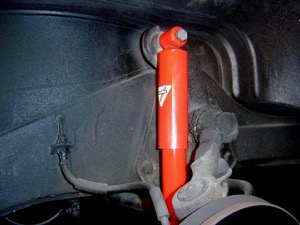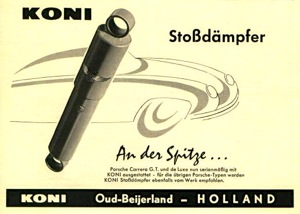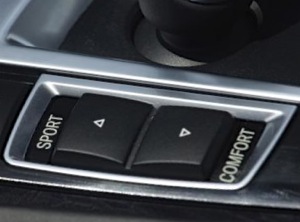by James Kraus

Koni adjustable damper at the front of a Porsche 356C
One of the disparities in the automotive lexicon is the term bestowed upon the damper/shock absorber. In Germany and the majority of the English speaking world, it’s a damper. In the U.S., France, Italy and Spain, it’s a shock absorber. Deciding which is the more correct designation depends to a large degree on the era under discussion.
In the early days of the device, damper was by far the more accurate description. Early units were designed solely to dampen suspension movement so as to limit oscillations of the springs following initial deflection. These oscillations would otherwise continue indefinitely were it not for various frictional constraints.
Due to their inherent design, original mechanical friction dampers could offer only equal resistance in either direction. Some early hydraulic dampers were the exact opposite; they were single-action units, offering damping resistance only in rebound.
Single-action units were definitely dampers, as they offered no resistance to any sort of shock or deflection, other than to limit downward wheel travel into a pothole. Although double-action hydraulic dampers were utilized by many manufactures since the 1920s, single-action units were still occasionally used for the next few decades.
Many vehicles, even though factory-fitted with double-action units, had comparatively little resistance in compression, sometimes as little as 20-30% of the rebound value. American cars were designed with very little damping in either compression or rebound.
In 1945, Koni of Holland introduced an adjustable, hydraulic double-acting damper that quickly became popular in motorsport. Although adjustable only in the degree of rebound damping, drivers noticed that even with this limited degree of adjustability, they could be used to great advantage in fine-tuning handling and chassis balance.

1950s Koni advertisement heralding their inclusion on the new Porsche 356 Carrera GT
Konis were stiffer in both compression and rebound than the majority of stock OEM models on their normal base (softest) setting, and this, combined with the increased rebound firmness available allowed for considerable improvement in body control and stability. Konis soon became standard equipment on Ferraris and a popular factory-fitted option on Porsches.
After extensive experimentation and testing, Porsche went so far as to publish a table of suggested front and rear settings for the optional Konis to guide their customers in preparing for rally, hill climb or circuit competition.
Eventually dampers with adjustability in both compression and rebound were developed. The next step was combining this variability with on-the-go adjustment via driver preference, automatic control, or a combination of both. The 1963 Mercedes-Benz 600 was an early example; the dampers having three manually selected settings which could be adjusted by the driver (or chauffeur) en route to best suit prevailing driving conditions.

The 600 driver could select the degree of damping via this steering wheel stalk adjacent to the turn indicator lever.
In the late 50s and early 60s, improvements in hydraulic fluids and damper design allowed damping rates to be notably increased without the risk of fluid foaming (which renders the damper temporarily inoperable.) These developments allowed suspension designers to achieve a better compromise of ride and handling by reducing spring rates and simultaneously increasing the compression resistance of the dampers beyond what had been the norm.
The result was a smoother, softer ride while preserving or even increasing the level of handling and steering response. This was possible largely due to the fact that a damper can be made much more “intelligent” than a spring.
Even the simplest all-mechanical non-adjustable units for example, usually have resistance which varies depending on piston (wheel) travel or velocity, automatically increasing compression damping (thus aiding the spring rate) when the car leans or dives excessively (long travel) or a tyre impacts a sharp bump (high velocity.)

BMW 750i Driving Dynamics control selector adjusts base levels of compression and rebound damping in addition to other vehicular parameters
Modern cars with adjustable suspension systems are even more sophisticated, allowing the driver to select various ride quality options, generally facilitated solely through adjusting the compression and rebound stiffness of the damper units, thus making them rather definitively shock absorbers (unless a firm or track setting is selected, whereby they could well be considered shock intensifiers) as much as dampers.
More advanced systems combine automatic continuous real-time adjustment of compression and rebound damping within the framework of the base-level setting selected by the driver.
The selected mode is usually combined with other parameters as well. Thus if the driver selects a “Sport” mode, not only is the base-level firmness of the dampers increased but generally, drive-by-wire throttle response is increased and the stability control activation threshold raised.
Though the primary function of dampers remains the damping of spring energy, over time they have assumed increasingly large roles in shock absorption and body control. Enough so that the terms damper and shock absorber are now equally valid.
What about steering dampers?
That is a different kettle of seafood; perhaps to be reviewed in the future in combination with the telescopic hydraulic clutch release arm damper fitted to the transaxle of early Honda Civics and/or the longitudinal hydraulic dampers fitted between the unibody and front subframe of the early Cadillac Seville.
Then of course there are the hydraulic fluid-filled tuned mass dampers (aka “Cocktail Shakers”) fitted to the four corners of some American convertibles in the 1960s…
Pingback: Four-Links – first Mustang sold to the public, or is | Hemmings Daily